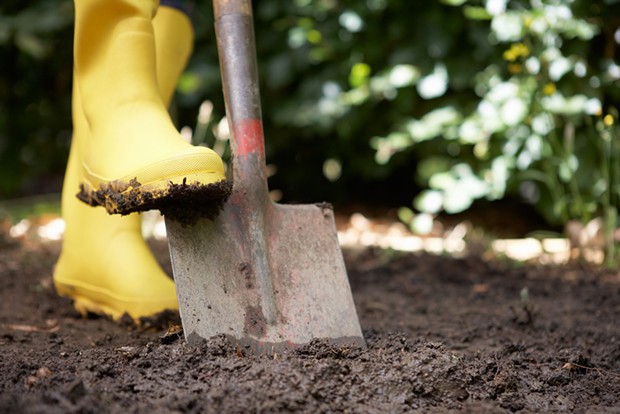[
{
"name": "Top Stories Video Pair",
"insertPoint": "7",
"component": "17087298",
"parentWrapperClass": "fdn-ads-inline-content-block",
"requiredCountToDisplay": "1"
}
]
Now that we're finally getting some much-needed rain, it's time to take stock of what to do in order to either have a fall garden, or prep your garden for the spring. You can do either or both (or nothing, if you're just over all that).
It's not too late to plant your garlic, onions and spring-flowering bulbs. I still have about, oh, 10 bags of bulbs to plant but I plan on waiting until a few dry days have passed after our rain. You can cause the soil to compact if you work it when it's wet or muddy. It's also unpleasant to work in the mud and it takes quite a bit to get the muddy clay off my boots. So, wait until we've had a few days of no rain, then get digging. As I mentioned last time ("Cleaning Up the Garden," Sept. 29, 2022), I usually plant my garlic in October, but this year, I'm taking the advice of Jennifer Bell and planting it in November. She reports she hasn't had any problems with rust (the fungal disease took down my entire crop this past year) planting in November. Remember: Garlic doesn't like competition with weeds, so make sure to put down a nice light mulch. I like to use rice straw, if it's available, but oat straw will do in a pinch. Make sure it's straw, not hay, which has seeds. Ask me how I know.
Another great rainy-day project is sharpening those garden tools. From pruners to shovels to hoes, a sharp tool makes gardening much easier.
For pruners, I usually carry a sharpening tool with me so I can quickly hone an edge, but it's a good idea to do a full cleaning and sharpening when you have time. The steps to sharpen your hand tools take more room than this column has but thespruce.com breaks it down into steps in "How to Clean and Sharpen Pruners."
Sharpen your shovels and spades, as well. Digging through roots or compacted soil is a lot easier if you have a sharp edge on that shovel. Again, more steps than I have room for, but there are a gazillion helpful YouTube videos and SFGate.com's "How to Sharpen a Spade Shovel" is solid.
There's still time to plant a fall garden, though by now it's probably better to purchase some pre-started plants at the local nurseries or the Arcata Farmers Market. Quite a few vendors grow veggie starts so you don't have to. The soil has cooled off enough that you won't want to plant any warm season crops but you can prepare those areas for next spring by planting a cover crop.
I need to get my cover crops in, as a matter of fact. Cover crops do a few things: They fix nitrogen in the soil, prevent erosion (once established), suppress weeds and, if they bloom, provide food for pollinators. Good cover crops here on the North Coast include clovers (white and crimson), vetch or field peas, fava beans and winter rye. Because I have chickens, I have to hide any cover crop with straw and some sort of barrier, otherwise the poultry will thank me for the delicious and very expensive snack. Cover crops grow all winter long and you cut them back or till them in the late winter/early spring to provide what's called green manure. Especially if you grow crops that are heavy feeders, such as tomatoes or corn, digging in a cover crop will provide lots of nutrients for the growing plants next year.
It's not too late to put in some plants in your yard or landscape, either. With the cooler days and nights, the plants get a chance to set down roots and get established. The California Native Plant Society still has plants available for purchase at the Freshwater Farms Reserve (5851 Myrtle Ave., Eureka). Now that the fall plant sale is over, the society is offering deals on the leftovers. You can find information about the nursery at northcoastcnps.org.
While it's a bit early for frost and freezes, inland communities did have one just a little while ago. Keep an eye on the weather forecast and if you see a freeze or frost warning, take action before the plants get blasted. Potted plants can be brought indoors (if you have space), and larger tender shrubs or trees benefit from some sort of drape. Nurseries sell lightweight cloth known as a floating row cover, but you can also use old sheets, pillowcases, lightweight blankets or drop cloths. Just make sure to leave space around the tree or shrub so there's room for the heat to stay inside the protective layer. Floating row covers work well over crops you want to protect from hard freezes, which are rare on the coast but not unheard of. A few items that always benefit from being covered in a frost or freeze are citrus trees and Princess flowers (Pleroma urvilleanum). Those gorgeous purple flowering shrubs get blasted every time we have several nights of freezing temperatures.
There's always something to do in or for the garden, no matter what the season.
Julia Graham-Whitt (she/her) is owner and operator of the landscaping business Two Green Thumbs.
more from the author
-
Working it Out in the Garden
- Jan 18, 2024
-
Winter Planting for Future Color
- Dec 21, 2023
-
Equinoctial To-Do and Native Plants
- Sep 21, 2023
- More »
































